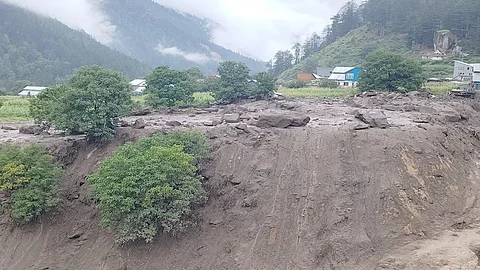

This is a two part series on the recent cloudbursts and environmental disasters in mountain areas of Jammu and Kashmir, India and Pakistan administered Jammu and Kashmir. Part II can be read here.
The summer of 2025 will be remembered not for elections, negotiations, or political intrigues, but for the fury of nature itself. In July and August, a series of violent cloudbursts and flash floods ripped across the Himalayan Belt, striking both sides of the Line of Control (LoC) in Jammu and Kashmir between India and Pakistan.
The devastation was impartial: entire villages were washed away in Indian-administered Kashmir; families in Pakistan-administered Jammu and Kashmir were buried alive; highways collapsed into gorges; and pilgrimage routes once seen as sacred became death traps.
Satellite imagery showed entire mountain slopes scarred by landslides. Valleys turned into lakes. Reservoirs downstream were choked with silt, quartz and logs. What unfolded was no mere seasonal storm. It was the lived evidence of a warning that scientists had issued for years: that the Himalayas are becoming a hotspot of climate instability.
For the people of Pakistan-administered Jammu and Kashmir (PAJK), the monsoon of 2025 arrived as devastation rather than relief. Cloudbursts tore through Neelum, Leepa, and Jhelum valleys, where homes and orchards cling precariously to the sides of mountains.
One of the starkest tragedies occurred in Sarli Sacha village, northwest of Muzaffarabad. A flood from Jhugiyan Nullah smashed into Nariyah Behak, burying six members of one family alive. The sole survivor was a guest who escaped with fractures. A local official overseeing the rescue spoke of pulling bodies from the wreckage by torchlight, the eldest daughter’s body discovered 150 feet downstream.
Road links to Muzaffarabad, Neelum Valley, and Bagh were severed for days. At Ratti Gali Lake, one of the region’s jewels, 700 tourists and villagers found themselves trapped after monsoon rains washed away the access road. Helicopters eventually rescued them, but only after hours of terror.
By mid-July, authorities in PAJK confirmed that the monsoon had already killed at least 22 people, injured dozens, and damaged more than 800 homes.
Across the LoC, Indian-administered Kashmir was struck by its own catastrophes. On 14 August 2025, a cloudburst devastated Chishoti village in Kishtwar, along the Machail Mata pilgrimage route.
Pilgrim camps were torn apart. Bridges collapsed in minutes. Official estimates put the death toll at 67, with more than 300 injured and hundreds missing. Families searched riverbanks for loved ones, while survivors spoke of the terror of walls of water crashing through the valley.
The Amarnath pilgrimage, already under scrutiny due to melting glaciers and expanding infrastructure, came under further examination. Environmental experts warned that monsoon surges and debris flows are now part of a dangerous new normal.
These disasters were not unique to Kashmir. Himachal Pradesh’s Mandi district experienced flash floods that swept away marketplaces. In 2014, floods along the Jhelum displaced half a million people. In 2022, Pakistan endured its deadliest monsoon in recorded history, with more than 1,700 lives lost.
Now, in 2025, the timeline of destruction has accelerated. Catastrophes that once stretched over months now unfold in mere weeks. The root cause lies in the science: every 1°C rise in temperature allows the atmosphere to hold 7% more water vapour. When this moisture-laden air collides with the Himalayan slopes, it releases torrents in minutes.
In July, Kashmir recorded its hottest daytime temperature in seventy years, at 37.4°C – at least seven degrees above normal. The results were catastrophic.
The Kolhoi and Machoi glaciers, which feed the Jhelum and Lidder rivers, are retreating at alarming rates. This retreat not only increases river discharge unpredictably but also destabilises moraines, making slopes more vulnerable to collapse. The Shishper and Pasu glaciers in northern Pakistan are also shrinking, further disturbing the ecosystem.
In places like Pahalgam and Sonamarg, thousands of pilgrims trample sensitive terrain every summer. Road expansions through permafrost zones accelerate the destabilisation of slopes. Glaciers that sustain rivers for millions are now being scarred by unregulated human activity.
The Jhelum and Chenab are more than rivers; they are veins that carry life across the Himalayas. Originating in Indian-administered territory, they flow into PaJK and further into Pakistan. A cloudburst in Kishtwar can devastate Neelum Valley downstream within hours.
Yet, real-time data is rarely shared across the LoC. Even if it is shared via the Indus Water Commission, currently kept in abeyance by India, it flows from New Delhi to Islamabad and then reaches Muzaffarabad for the authorities to take action.
During July and August, this lack of coordination cost lives. Families in Neelum were caught unaware by surges that originated upstream. On the other side, authorities lacked information about breached embankments downstream of Muzaffarabad.
The message is stark: nature does not recognise borders, but human institutions do – and people pay the price.
Climate change is the primary driver, but human exploitation magnifies the scale. The Amarnath and Machail pilgrimages attract hundreds of thousands without adequate environmental regulation. Hotels and resorts choke wetlands in Gulmarg and Neelum Valley. Logging and quarrying strip slopes of natural cover.
In July, after floods struck, the intake dam of the Neelum–Jhelum Hydropower Project was found clogged with logs – a stark symbol of rampant deforestation.
Every unregulated road, every additional hotel, every camp carved into fragile slopes erodes the Himalayas’ ability to withstand stress. Climate instability meets human recklessness, and disaster follows.
The summer of 2025 has revealed a truth that the region can no longer afford to deny: climate disasters are systemic, not episodic. They will return, fiercer and faster, unless the rivers and slopes are treated as shared lifelines rather than contested ground.
The Himalayas have spoken in floods and landslides. The question now is whether we will listen.
Have you liked the news article?